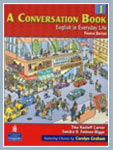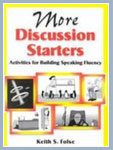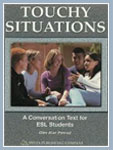Conversation Classes
Lynn Henrichsen
Scenario: An American professor in Japan

A friend and colleague of mine who is an accomplished physics professor at a large research university in the United States recently went to Japan on an academic exchange. The main purpose of his trip to Japan was to do research in physics. Nevertheless, after he’d been in Japan a few weeks, he was approached by some Japanese acquaintances and asked to teach an English conversation class—not at the university but in the community. Even though he had been speaking English all of his life and his life work involved teaching, he felt rather inadequate. He had never taught the English language to anyone, and he had no idea where to begin. Nevertheless, he wanted to be polite and helpful to his Japanese friends, so he couldn’t refuse their request. They were very happy and told him that the class would begin the following week. My friend ended up having the Japanese students make chocolate chip cookies in class. That was a tasty, creative, and culture-based solution!
Think
- What would you do in this situation?
- How would you go about teaching a conversation class for English language learners?
- What could you do to make it both effective and enjoyable?
Objectives of this Unit
As you work through this unit, you will…
- Become aware of several common challenges associated with ESL/EFL conversation classes (selecting the right conversation topics, establishing a supportive classroom atmosphere, keeping everyone speaking English, managing the class properly, and correcting students' mistakes in a non-intrusive and non-intimidating way)
- Understand how to address each of these challenges
- View a video clip of an actual EFL conversation class taught by a novice teacher and reflect on what you see.
- Plan how you might apply the principles presented in this unit in your own ESL/EFL conversation classes in the future. After you have done these things, you will be ready to experience conducting your own conversation class by:
- Selecting an appropriate topic
- Establishing a supportive atmosphere
- Keeping everyone on task speaking English
- Managing the class’s activities
- Correcting students’ mistakes in a way that doesn’t interrupt or intimidate them.
If you have learned well, your conversation class will be both enjoyable for those involved and effective in helping them improve their English skills.
The least you should know
The main objective of most conversation classes is to get the English learners to talk-in English, of course. With some groups this is easy, with others it is more challenging.
The keys to success include…
- Selecting the right conversation topics
- Establishing a supportive classroom atmosphere
- Keeping everyone speaking English
- Managing the class properly
- Correcting students' mistakes in a non-intrusive and non-intimidating way
The remainder of this section will talk about each of these topics in turn.
Topic selection (Appropriateness = Interest + Linguistic Level + Cultural Content)
Choosing an appropriate topic is crucial. Appropriateness depends not only on the subject matter's interest to the students but also on the level of linguistic ability needed to talk about it, as well as its cultural content.
1.1 Topic Selection (Getting student input)
- The best (and easiest) way to find out what topics are of interest to your students is to simply ask them. If necessary (and if possible), you can ask them this question in their native language(s). If, however, you don't speak your students' native language, don't have a translator, or are teaching a class whose members speak many different languages, you can conduct this discussion in English.
1.2 Topic Selection (Student background knowledge—linguistic and cultural)
- Interest is only the first of several factors you must consider when choosing a topic for conversation. Student background knowledge (linguistic and cultural) is another. A crucial factor in choosing a good conversation topic is the level of English proficiency students need to talk about it
1.3 Topic Selection (Some common, popular topics)
- Some popular conversation class topics are listed below (in order of increasing difficulty)
- Family (members and relationships)
- Work (your job) or school (your classes)
- Best friend (and what makes him/her a friend)
- Something you really like about yourself
- Something you experienced and will never forget
- If you could be someone else, who would you be?
- What would you do with a million dollars?
Comprehension (and reflection) questions

- What might the advantages (and disadvantages) of trying to conduct a class conversation in English about what topics are of greatest interest to your students?
- Name and explain at least two factors that need to be taken into consideration when choosing conversation topics.
- Can you think of some cultural settings where talking about topics (such as those listed above in section 1.3) that are perfectly acceptable in most settings might be unacceptable?
Class atmosphere
For a conversation class to succeed, the interpersonal atmosphere in the group must be supportive. To speak up and participate in a conversation in a language that is foreign to them, people need to feel free to take risks without fear of embarrassment. (See Unit 22, Language Learning Strategies.)
2.1 Class atmosphere (Avoid drawing attention to students’ mistakes)
- If your students mispronounce a word, use an incorrect word, or make a grammar mistake when expressing themselves, don’t draw attention to it unless it interferes with communication. You may want to talk about the linguistic problem later, but for now just let the conversation continue. (See the section below on responding to students’ mistakes.)
2.2 Class atmosphere (Don’t let students intimidate each other)
- Make sure that students also respect each other’s attempts to communicate The fastest way to kill a developing conversation is to allow someone in the class to ridicule or laugh at other students’ mistakes. When students feel afraid to speak, their “affective filter” (see unit 13 Basic Principles of Second Language Acquisition) goes up and their rate of learning goes down.
Speaking in English
People learn to speak a language by speaking it. One of the purposes of your conversation class is to maximize the time that you students speak English, and not their native languages. Getting them to speak English with each other, however, can be difficult—especially if class members speak the same native language.
3.1 Speaking in English (English as a Second Language settings)
- If you are teaching a class that consists of speakers of various different languages (e.g., an ESL class with speakers of Spanish, Chinese, Korean, Polish, and Arabic), it will be natural for them to speak to each other in English since they don’t understand each other’s native languages. The only challenge may come when you have students work in small groups. Then you will probably want to engineer those groups so that they contain speakers of different languages.
3.2 Speaking in English (English as a Foreign Language settings)
- If, on the other hand, you are teaching a class whose members all speak the same language (e.g., an EFL class in Japan, with all Japanese speakers), then you may need to take extra steps to encourage them to use English in class. One way of doing this is to post a “Here we speak English” sign that is clearly visible. If students start speaking their native language when they should be speaking English, simply point to the sign. To encourage students to speak in English you can also set up a simple reward system (with tokens, pieces of candy, etc.) for those who speak in English.
Class management
There are a few other things you need to know about managing your conversation class in order to make it run smoothly and well. (See also, Unit 11, Managing classes of English language learners.)
4.1 Class management (Avoid teacher domination)
- A great temptation in class where you are the fluent, proficient speaker of English and everyone else is struggling with the language is for you to do all the talking. Resist that temptation. Avoid teacher domination. Wait patiently and give your students time to think and mentally prepare their utterances before they speak them.
4.2 Class management (Keeping some students from dominating others)
- It is also likely that some of the students in your conversation class will be more proficient and fluent than others. These students may also dominate the class and prevent the less proficient speakers from participating as they should. One way to overcome this class management problem is to regulate turn taking by students by establishing class rules or distributing tokens to students so the less proficient speakers will not be dominated by the more proficient ones.
Responding to mistakes
In free conversations among language learners, it is inevitable that they will make mistakes—sometimes many mistakes. However, if you interrupt the flow of conversation to correct every mistake, you will quickly kill the conversation and intimidate your students. The conversation will cease, and so will the usefulness of your class.
5.1 Responding to mistakes (Addressing errors without interrupting)
- Instead of correcting mistakes as they occur, you may want to take notes on the most common ones. Then, after the conversation session is over, you can comment on those mistakes and how to correct them. This procedure will not interrupt the conversation or intimidate your students, yet they will feel like they are being given some instruction.
5.2 Responding to mistakes (Echo correction)
- Another way to respond to mistakes is called “echo correction.” When a student says something that contains an error (e.g., “My house has many furnitures.”), all you have to do is nod, smile, and “repeat” the utterance but with the correct form (e.g., “I see. Your house has much furniture.”). It may sound like you are merely agreeing with the student, but you are also providing a correct model. If the student is ready to learn the correct form or simply needs a reminder of it, he/she will pick up on your correction. He/she may even self-correct and repeat the original utterance (e.g., “Yeah, my house has much furniture.”)
That’s it. That’s “the least you should know” about conducting effective and enjoyable conversation groups. Of course, there is much more that you will learn later—from other sources or from your own experience.
Comprehension and reflection questions
- If you have studied a foreign language, what experiences have you had with error correction? How did your teachers correct your mistakes? How did you feel about that?
- Students’ willingness to speak up, take risks, make mistakes, and participate in conversations depends to a degree on their cultural background. What cultural background(s) do your students come from, and how might that background make them more or less inclined to participate in class activities involving speaking?
Video Examples
Here is a video clip of a conversation class led by a novice teacher. This particular class was in Guadalajara, Mexico.
Reflection and Responses
As you view this video clip of an EFL conversation class, think about each of the following questions.
- What was especially good about this class? (What did the teachers and students do right?)
- What teaching principles/techniques discussed earlier in this unit did you notice in this clip?
- What adaptations could you make for the situation you are (will be) teaching in?
- What other things might you do differently to make your lessons even better?
Here is what other people have said after viewing and reflecting on this video clip.
- What was especially good about this class? (What did the teachers and students do right?)
The atmosphere was very friendly and supportive. Everyone seemed to be at ease, and the student was not afraid of speaking up. The topics (“Your best friend” and “A fun time”) was of interest to the students and at the right level for their English. The teacher provided a model before asking the students to speak. - What teaching principles/techniques discussed earlier in this unit did you notice in this clip?
The teachers did not interrupt when the student made a mistake (e.g., “When we was dating.” Or “They was eating.”) or even when the student misunderstood the second conversation topic (fun vs. funny). The teachers provided support (via translation) when the student struggled with English words (compartir? Share, podridos? Rotten. One teacher used echo correction when the student said “They was eating” for the second time - What adaptations could you make for the situation you are (will be) teaching in?
The topic might be a little difficult for my students. I don’t think they will be as fluent as the guy in the video. - What other things might you do differently to make your lessons even better?
Rather than having such strict turn-taking, it might be better to have more interaction. Students could talk with each other back and forth—maybe even in pairs, instead of the whole class just listening while student speaks.
Where to go to learn more
Here’s where you get additional information on the topics presented in this unit.
Connections to other units in this program
Here are some other units in this program that relate to topics we have addressed in this unit.
- Unit 11, “Managing classes of English language learners.”
- Unit 12, “Providing performance feedback, correcting errors, and developing self-monitoring skills.”
- Unit 22, “Language-learning strategies.”
- Unit 33, “Songs.”
- Unit 34, “Games.”
If you want additional information on any of these topics, you might consider looking at these units.
Print and paper-based resources
Here are some published books that have proven to be helpful resources for teaching conversation classes:





Tina Kasloff Carver and Sandra Douglas Fotinos. A Conversation Book 1: English in Everyday Life. (4th ed.) Pearson/Prentice-Hall. “This book presents picture dictionary-type pages, along with conversation and grammar practice, that provide readers with the vocabulary and speakinq skills they need for everyday life” ISBN 0131722395
Keith Folse and Jeanine Ivone. More Discussion Starters: Activities for Building Speaking Fluency. Ann Arbor: University of Michigan Press, 2002. “More Discussion Starters includes more of the same type of quirky conversation activities for upper-level ESL/EFL students. Like its predecessor, each unit in More Discussion Starters contains exercises that provide speaking interaction about a central topic or idea, and most require students to work together in pairs or small groups to reach a conclusion about a topic. Though most of the topics in the text are serious (corporal punishment, abortion, and gun control), many others deal with lighter topics (humor and culture). The activities, tasks, and topics chosen for this book are real situations from all over the world. Most of the units in this book introduce a problem or controversial topic at the beginning of the unit. This is then followed by a series of exercises designed to prepare all of the students so that they can express their ideas at the next class meeting. A unit usually includes several kinds of oral fluency activities, such as problem-solving tasks, court cases, "finish the story," role plays, "put the story together," small group discussions, and oral presentations.” ISBN 978-0-472-08855-3
Keith Folse. The Art of Teaching Speaking. University of Michigan Press, 2006. “What elements make a speaking activity successful? Which tasks or activities really help build speaking fluency? What does the research show regarding speaking activities? What mistakes do ESL teachers often make in speaking activity design? In this highly accessible and practical resource, Keith S. Folse provides a wealth of information to help ESL/EFL teachers design and use speaking tasks that will actually improve students’ speaking fluency.” ISBN 0-4720-3165-1
Glen Alan Penrod. Touchy Situations: An Advanced Conversation Text for ESL Students. Dymon/Delta, 2002. “Your friend has bad breath (but doesn't know it); you are married but would rather be single; Johnny is caught playing with matches; you are a perfectionist and your roommate is a slob. Yikes! What do you do? This situation-based conversation text provides challenging--sometimes touchy--topics in an effort to help students bridge the gap between controlled and free expression. Incorporating four main lesson formats (information gap activities, small group discussion, face-to-face role plays, and discussion and presentation), each of the 20 lessons takes approximately 90 minutes to complete.” ISBN 0-9637742-0-4.
Nancy Ellen Zelman, Esq. Conversation Inspirations: Over Two Thousand Conversation Topics (2nd rev. ed.). Brattleboro, VT: Pro Lingua Associates, 1996. “Over 2000 conversation topics. Role plays, interviews, talks, group creativity, proverbs & superstitions, chain stories, find out, get your partner, discussions.” “The more than 2400 topics range all the way from the universal - human nature and interpersonal relationships - to the culturally vital - cutting edge issues in North American society and how people from other cultures feel about them and deal with them.” ISBN 0-86647-094-8 (Revised and expanded in 2005: ISBN 0-86647-195-2).
If you have suggestions for other resources (books, websites, etc.), please send them to BTRTESOL@byu.edu